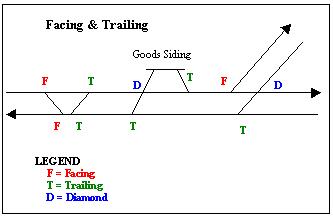Facing and trailing on:
[Wikipedia]
[Google]
[Amazon]
 Facing or trailing are railway turnouts (or 'points' in the UK) in respect to whether they are divergent or convergent. When a train traverses a turnout in a facing direction, it may diverge onto either of the two routes. When travelled in a trailing direction, the two routes converge onto each other.
Facing or trailing are railway turnouts (or 'points' in the UK) in respect to whether they are divergent or convergent. When a train traverses a turnout in a facing direction, it may diverge onto either of the two routes. When travelled in a trailing direction, the two routes converge onto each other.
 Facing or trailing are railway turnouts (or 'points' in the UK) in respect to whether they are divergent or convergent. When a train traverses a turnout in a facing direction, it may diverge onto either of the two routes. When travelled in a trailing direction, the two routes converge onto each other.
Facing or trailing are railway turnouts (or 'points' in the UK) in respect to whether they are divergent or convergent. When a train traverses a turnout in a facing direction, it may diverge onto either of the two routes. When travelled in a trailing direction, the two routes converge onto each other.
History
In the early history of railways in Britain, when signalling andinterlocking
In railway signalling, an interlocking is an arrangement of signal apparatus that prevents conflicting movements through an arrangement of tracks such as junction (rail), junctions or crossings. The signalling appliances and Track (rail transpor ...
were primitive, and staff were inexperienced, facing turnouts were a hazard, because a train travelling at high speed could be accidentally switched into a slow speed divergence or dead end. Facing turnouts were therefore banned, except when absolutely necessary. However, facing turnouts cannot be avoided where there are crossing loop
A passing loop (UK usage) or passing siding (North America) (also called a crossing loop, crossing place, refuge loop or, colloquially, a hole) is a place on a single line railway or tramway, often located at or near a station, where trains or ...
s on single lines.
With the widespread availability of electrically interlocked signalling in modern times, the rule against facing turnouts has been relaxed.
Diamond crossings
Fixeddiamond crossing
A double junction is a railway junction where a double-track railway splits into two double track lines. Usually, one line is the main line and carries traffic through the junction at normal speed, while the other track is a branch line that ...
s (with no moving parts) count as trailing points in both directions, although in very exceptional circumstances such as propelling a train in reverse over fine angle diamond crossings they can derail wagons as they bunch up.
Switched diamond
A double junction is a railway junction where a double-track railway splits into two double track lines. Usually, one line is the main line and carries traffic through the junction at normal speed, while the other track is a branch line that c ...
s, which contain two stub turnouts in disguise, count as facing turnouts in both directions and are also known as moveable angles (UK).
Moveable crossings
Fixed V-crossings are trailable in both directions. Moveable crossings are effectively facing in both directions and must be correctly aligned.Stub switches
Stub switches are effectively facing in both directions and must be correctly aligned.Double junctions
Double junction
A double junction is a railway junction where a double-track railway splits into two double track lines. Usually, one line is the main line and carries traffic through the junction at normal speed, while the other track is a branch line that c ...
s are now configurable in a number of different ways, whereby the number of facing and trailing turnouts vary.
Goods siding
The goods siding on a double line (in the above diagram) uses two trailing points and a diamond. It can be shunted by trains in either direction. This was widely done inNew South Wales
)
, nickname =
, image_map = New South Wales in Australia.svg
, map_caption = Location of New South Wales in AustraliaCoordinates:
, subdivision_type = Country
, subdivision_name = Australia
, established_title = Before federation
, es ...
, though later on the diamond crossing was replaced with a pair of ladder crossovers; such as:
* Bredalabane (S)
* Jerrawa (S)
* Woy Woy
Woy Woy is a coastal town in the Central Coast region of New South Wales, Australia, located on the southern reaches of Brisbane Water north of Sydney. It is a population centre within the local government area.
Woy Woy is located in the no ...
(N)
* Newbridge (W)
References
{{Railway track layouts Rail junction types